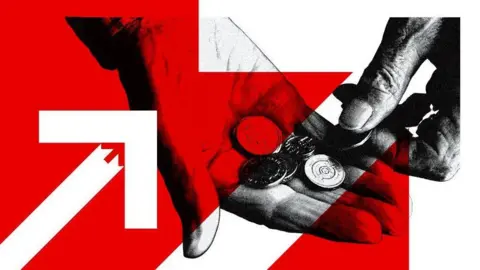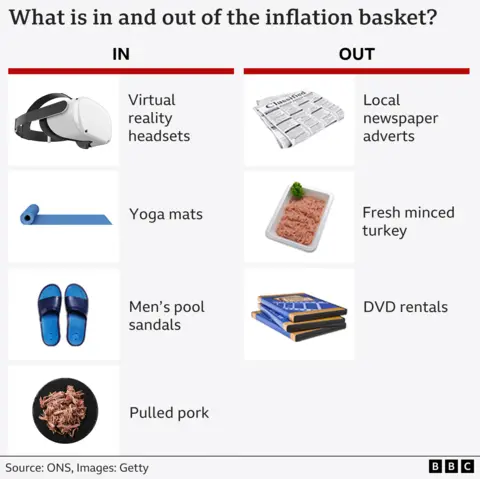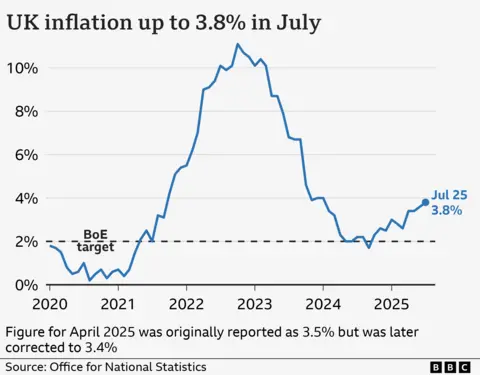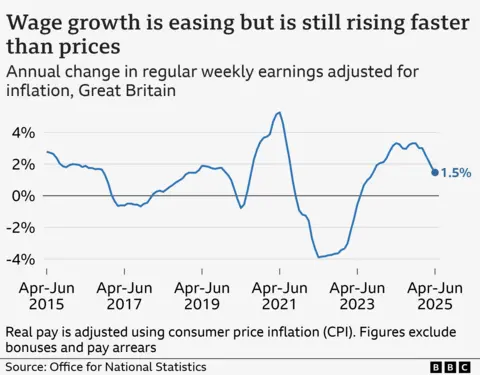 BBC
BBCPrices in the UK rose by 3.8% in the 12 months to July, driven by higher air fares, as well as increases in the cost of food.
It means inflation remains above the Bank of England’s 2% target.
The Bank moves interest rates up and down to try to keep inflation at that level, and has cut interest rates five times since August 2024.
What is inflation?
Inflation is the increase in the price of something over time.
For example, if a bottle of milk costs £1 but is £1.05 a year later, then annual milk inflation is 5%.
How is the UK’s inflation rate measured?
The prices of hundreds of everyday items, including food and fuel, are tracked by the Office for National Statistics (ONS).
This virtual “basket of goods” is regularly updated to reflect shopping trends, with virtual reality headsets and yoga mats added in 2025, and local newspaper adverts removed.

The ONS monitors price changes over the previous 12 months to calculate inflation.
The main inflation measure is called the Consumer Prices Index (CPI), and the latest figure is published every month.
CPI was 3.8% in the year to July 2025, up from 3.6% in the 12 months to June. The July 2025 figure is the highest recorded since January 2024, when the rate was 4.0%.

The Bank also considers other measures such as “core inflation” when deciding whether and how to change rates.
This doesn’t include food or energy prices because they tend to be very volatile, so can be a better indication of longer term trends.
Core CPI was 3.8% in the 12 months to July, up slightly from 3.7% recorded in the year to June.
Why are prices still rising?
Inflation has fallen significantly since hitting 11.1% in October 2022, which was the highest rate for 40 years.
But that doesn’t mean prices are falling – just that they are rising less quickly.
Inflation soared in 2022 because oil and gas were in greater demand after the Covid pandemic, and energy prices surged again when Russia invaded Ukraine.
It then remained well above the 2% target partly because of higher food prices.
These continue to be a significant factor in the current inflation figures.
Inflation for food and non-alcoholic beverages was 4.9% in the year to July, up from 4.5% in the year to June.
Beef, sugar, chocolate, instant coffee and fruit juice saw significant price rises.
But the main factor driving the July inflation figure was higher air fares, which saw the largest July increase since the ONS began collecting that data on a monthly basis in 2001.
In addition, fuel prices fell only slightly between May and June 2025, compared to a larger drop in the same period in 2024.
Why does putting up interest rates help to lower inflation?
When inflation was well above its 2% target, the Bank of England increased interest rates to 5.25%, a 16-year high.
The idea is that if you make borrowing more expensive, people have less money to spend. People may also be encouraged to save more.
In turn, this reduces demand for goods and slows price rises.
But it is a balancing act – increasing borrowing costs risks harming the economy.
For example, homeowners face higher mortgage repayments, which can outweigh better savings deals.
Businesses also borrow less, making them less likely to create jobs. Some may cut staff and reduce investment.
In recent months inflation has remained above the Bank’s target at the same time as the economy has remained relatively flat and the jobs market has softened.
Therefore, the Bank has chosen to cut rates, despite high inflation, in an attempt to encourage people to spend more and get businesses to invest and create jobs to boost the economy.
What is happening to UK interest rates and when will they go down again?
The Bank of England began cutting rates in August 2024, and made five cuts to bring the rate down to 4%.
Bank of England governor Andrew Bailey had said that future cuts will be made gradually and carefully.

The August interest rate decision was extremely close, with the committee voting 5-4 to cut rates by a quarter percentage point.
It followed an unprecedented second vote by the Bank’s policymakers, as one economist wanted a larger cut of half a percentage point.
This suggests future interest rate decisions could also be finely balanced.
Inflation is now expected to peak at 4% in September, the Bank said in its latest Monetary Policy Report. That is twice the Bank’s target rate and above the 3.8% spike it predicted in its previous report in May.
A further interest rate cut had been expected at the Bank’s meeting in November, but analysts are now less sure this will happen given the closeness of the August vote.
The Bank also has to consider the wider global economy. Mr Bailey has repeatedly warned about the unpredictable impact of US tariffs, and conflict in Israel and Iran has also created uncertainty.
Are wages keeping up with inflation?

Annual average regular earnings growth was 5.7% for the public sector and 4.8% for the private sector.
Meanwhile, separate ONS figures showed the number of vacancies fell again to 718,000 for the May to July period, marking three continuous years of falling job openings.
The unemployment rate was 4.7% in the three months to July – the same as the three months to April.
This marked the highest level of unemployment since June 2021, and is also likely to factor into the Bank of England’s decision whether to cut rates again.
What is happening to inflation and interest rates in Europe and the US?
The US and EU countries have also been trying to limit price increases.
The inflation rate for countries using the euro was 2.0% in July.
In June 2024, the European Central Bank (ECB) cut its main interest rate from an all-time high of 4% to 3.75%, the first fall in five years.
By July 2025, after several further cuts, its key rate stood at 2%.
Inflation in the US held steady at 2.7% in July, remaining above the US central bank’s 2% target.
After a string of cuts in the latter part of 2024, the US central bank again chose not to change rates at its July 2025 meeting, the fifth hold in a row.
That leaves its key interest rate unchanged in a range of 4.25% to 4.5%.
The Federal Reserve has repeatedly come under attack from President Trump, who wants to see further interest rate cuts.





